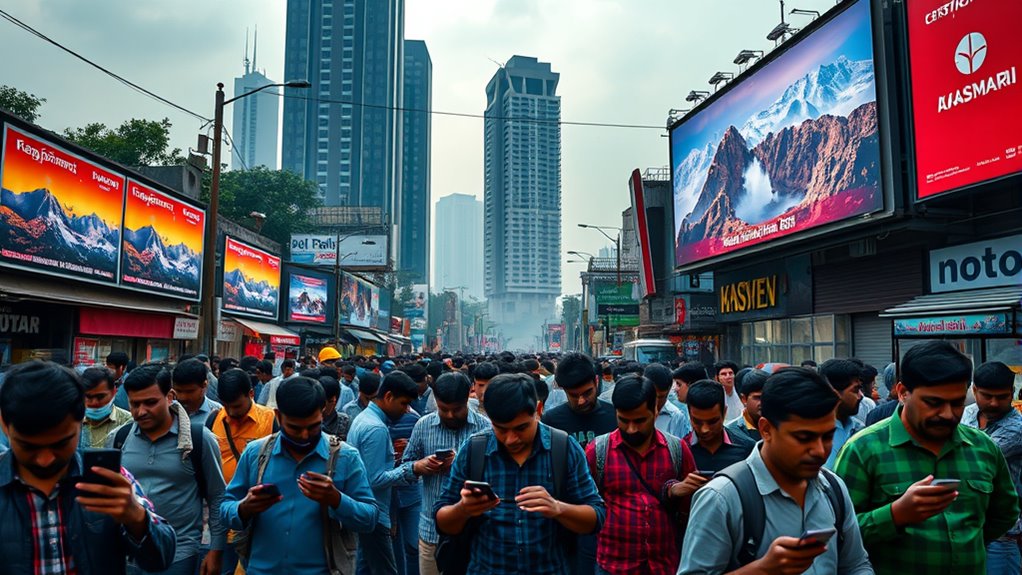India's accusing China of using AI bots to spread disinformation about Kashmir. These bots reportedly manipulate public opinion and undermine democratic processes during critical times. With advanced AI technology, China fuels false narratives, raising alarms about the risks of deepfakes and deceptive content online. In response, India is implementing measures to combat this misinformation and protect its democracy. Stick around to uncover more about how both nations are navigating this digital battleground.
Key Takeaways
- India alleges that China employs AI bots to disseminate misinformation regarding Kashmir, particularly during sensitive political periods.
- The use of advanced AI technology by China enhances its capacity to manipulate public opinion and spread false narratives.
- Accusations include the deployment of generative AI tools to create misleading content that undermines democratic processes in India.
- India's IT Ministry has responded with regulatory measures aimed at holding tech companies accountable for AI-generated misinformation.
- Initiatives promoting digital literacy in India focus on enabling citizens to identify and combat misinformation, particularly in relation to Kashmir.

As concerns about misinformation grow, India has accused China of deploying AI bots to manipulate public opinion and spread false narratives, particularly during critical times like elections. This accusation points to the broader issue of AI-generated content being used to mislead the public and undermine democratic processes. You might be aware that AI tools have become increasingly sophisticated, enabling the creation of highly convincing yet fabricated information. In this context, India's worries about China's capabilities aren't unfounded, especially given the advanced AI technology China possesses and its potential for generative AI in spreading misinformation.
China's strategic approach, often described as the San Zhong Zhanfa strategy, involves public opinion warfare, psychological tactics, and legal maneuvers. You should take note of how China has previously launched disinformation campaigns, especially during the COVID-19 pandemic, aimed at discrediting India and shaping narratives that serve its interests. The use of social media platforms amplifies these narratives, allowing them to reach a wider audience and influence public sentiment significantly.
AI-generated videos and deepfake technology are particularly concerning. These tools can create deceptive content that manipulates audio, images, and videos, making it increasingly difficult for you to distinguish between what's real and what's not. The proliferation of inauthentic social media accounts designed to spread misinformation adds another layer of complexity to this issue. You might find it unsettling that the very platforms designed to connect people are being exploited to sow discord and confusion.
In response, India has taken steps to curb this misuse of AI. Regulatory measures have been implemented, with the IT Ministry issuing directives for tech companies to ensure accountability for AI-generated content. Additionally, the Indian government has emphasized the importance of proactive measures against misinformation and deepfakes to safeguard the democratic process. The Election Commission has also warned against the potential dangers posed by deepfakes during elections, aiming to safeguard the integrity of the democratic process.
To combat the spread of disinformation, India has initiated digital literacy programs to help citizens identify fake news and misinformation. However, the challenge remains significant. As AI continues to evolve, its role in political campaigns can be a double-edged sword. While it can engage voters, it also poses a risk of spreading disinformation that could sway public opinion unfairly.
You can see how critical it's for democracies like India to remain vigilant and proactive in addressing these issues, ensuring that the information landscape remains transparent and trustworthy.
Frequently Asked Questions
What Specific Disinformation About Kashmir Is Being Spread by AI Bots?
You might encounter various types of disinformation about Kashmir being spread by AI bots.
They often circulate false reports of violence, claiming mass killings or unrest that aren't happening. Misleading videos might pop up, showing fabricated military actions or outdated footage.
Additionally, you'll see political propaganda questioning India's sovereignty over the region.
This misinformation aims to create confusion and amplify tensions, influencing public perception and international response regarding Kashmir.
How Does India Plan to Counter These AI Bot Activities?
Did you know that 70% of people tend to believe misinformation shared on social media?
To counter AI bot activities, India's implementing digital literacy programs and AI detection tools.
You'll see increased fact-checking initiatives, partnerships with tech companies, and the development of regulatory frameworks to combat misinformation.
What Evidence Supports India's Accusations Against China?
You'll find several pieces of evidence supporting accusations against China regarding disinformation.
AI-generated content, including fake videos and audio, spreads misleading narratives on social media. Inauthentic accounts linked to Chinese operations amplify these falsehoods.
You can see the impact in regions like Kashmir, where disinformation campaigns manipulate public opinion.
Additionally, China's targeting of specific ethnic groups and using deepfake technology raises concerns about their intent to destabilize and influence perceptions in India.
Are There Any International Reactions to This Situation?
Isn't it alarming how quickly misinformation can spread?
International reactions to disinformation, especially AI-driven, have been significant. Countries are recognizing the threat it poses to democracies and public discourse.
The UN emphasizes the need for legal and proportional measures against it. Tech companies are collaborating to create detection tools, while calls for regulation grow louder.
It's clear that addressing AI misuse requires a united global effort to safeguard democratic processes.
How Do AI Bots Operate in Spreading Disinformation?
AI bots operate by generating and spreading fake content, mimicking human behavior to evade detection. They create realistic profiles and use them across various social media platforms.
By amplifying specific narratives and manipulating public opinion, they influence discussions significantly. With scalable capabilities, they can post, comment, and even generate deepfakes, further muddying the waters of trust in information.
Combating this requires awareness, tools for detection, and education on digital literacy.
Conclusion
In this escalating digital war, India's accusation against China reveals how disinformation can spread like wildfire in a dry forest. As AI bots become more sophisticated, the battle for truth intensifies, leaving citizens caught in the crossfire. It's crucial for people to stay vigilant and question the narratives presented to them. Only by doing so can they protect themselves from being manipulated and ensure that the real story of Kashmir isn't lost in the noise.









